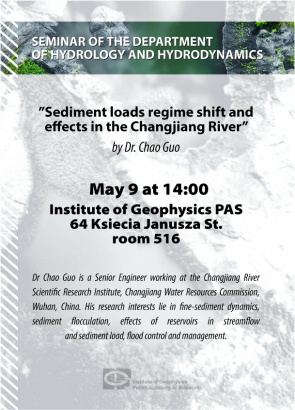Seminarium naukowe dotyczące zmiany reżimu ładunków osadów w rzece Jangcy
Serdecznie zapraszamy na seminarium naukowe organizowane przez Zakład Hydrologii i Hydrodynamiki, które odbędzie się w Instytucie Geofizyki Polskiej Akademii Nauk 9 maja o godz. 14:00 w Instytucie Geofizyki Polskiej Akademii Nauk, ul. Księcia Janusza 64, sala 516. Seminarium pt. "Sediment loads regime shift and effects in the Changjiang River" poprowadzi dr Chao Guo z Instytutu Badań Naukowych Rzeki Jangcy.
Dr Chao Guo, starszy inżynier, pracujący w Instytucie Badań Naukowych Rzeki Jangcy, Komisji ds. Zasobów Wodnych Jangcy. (Wuhan, Chiny) Jego zainteresowania badawcze obejmują dynamikę osadów drobnych, flokulację osadów, wpływ zbiorników na przepływ i obciążenie osadami, kontrolę i zarządzanie powodziami.
Abstract
Sediment loads regime shift and effetcs in the Changjiang River
Sediment transport from rivers to oceans is of primary importance in global geochemical cycle. Many large rivers in the world, in particular in the global hydrologic north, deliver decreasing sediment loads to coastal oceans owing to reductions in sediment yield and disrupted sediment deliver. As one of the world’s largest river systems, the Changjiang River (CR) basin (mainstem length of ~6400 km, and drainage area of ~1.9 million km2, and annual streamflow of ~900 billion m3) has occurred marked sediment loads regime shift in the past a few decades, mainly due to the constructions of Three Gorges Dam (TGD) and a series of other hydropower dams. The sediment loads have decreased progressively throughout the basin with ~90% and ~70% at the outlets of the upper basin and entire basin, respectively. The upper reach of CR has shifted from sediment source to sink zone (including very fine sediment), while the middle-lower river has changed from a slight depositional to a severe erosional environment. Moreover, these low-level sediment loads will likely persist in the future considering the cumulative dam trapping and depleted channel erosion. As a result, substantial changes of sediment and adherent nutrients fluxes, river morphology have occurred that affect the water supply, flood mitigation, and the aquatic ecosystem etc. in the CR basin. The studies and lessons in the CR can shed light on other river systems subject to intensified human interference.



















